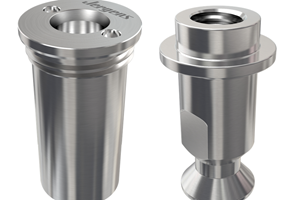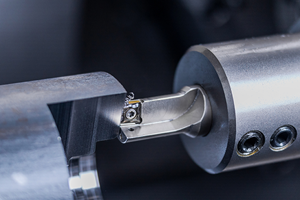Choosing Toolholders For Your Machining Center
How the toolholders for your machining center are manufactured. Toolholder geometry, size and surface finish all have an effect on the cutting accuracy.
It matters how the toolholders for your machining center are manufactured. Toolholder geometry, size and surface finish all have an effect on the cutting accuracy, repeatability and tool life you can squeeze from any machining center on your shop floor brand new or several years old.
After all, the toolholder is key to rigid, accurate metalcutting. The taper of the toolholder as well as the bore for the tool or collet must be the correct size, and must be concentric. Old toolholders, produced to less rigorous standards, can limit the metalcutting accuracy of even the latest, high speed machining center.
Before purchasing your next tool-holders, review these factors carefully:
- Machine Spindle Style and Size - While most machining centers are equipped with V-flange style spindle tapers, BT-style spindle tapers are becoming more popular on smaller spindle, high speed machines. The HSK shank is becoming more popular, especially in high speed spindles and close-tolerance aerospace work. Carefully select toolholder shank type, size and retention knob (if applicable) to your machine spindle.
- Machining Center Spindle RPM - The increasing cutting speeds of today's machining centers10,000, 20,000, even 30,000 rpm cutting--mean that balanced toolholders are vital. Standard toolholders for lower speed work will not maintain accuracies achievable with balanced toolholders. The typical CAT V-flange toolholder has 250 g/mm unbalance, primarily due to the drive slot design. Additional imbalance is always introduced by setscrews and collets where used. Balance quality specifications for machine spindles is 2.5 g/mm at rated spindle speed. Ideally, the complete tool assembly should be balanced prior to installation in the machine spindle.
When upgrading toolholders, plan to buy holders certified to be dynamically balanced in two planes. The most reliable toolholders will be CNC machined and ground, as well as balanced on a dedicated toolholder balancing machine that enables precise correction for imbalances inherent in all V-flange tooling.
Users find that balanced holders at any speed eliminate vibration, which permits faster metal removal rates, increased tool life and improved machined surface finishes due to balanced chip loads, as well as complete utilization of cermet and carbide insert technology through their optimum recommended feeds and speeds.
- Concentricity Between Shank and Bore - Toolholder taper accuracy proposed in ANSI (American National Standards Institute) standard AT3, and bore diameters to 0.0002 inch TIR relative to the taper, are essential to repeatable, precision metal-cutting. Look for shank tolerance of AT3 or better, concentricity within 0.0002 inch, and repeatability of 0.0002 inch to ensure the tooling will meet the cutting accuracy potential of your machining center. AT3 refers to spindle taper accuracy of 1/3 of the originally proposed standard of 0.001 inch/12 inches of taper, or 0.00033 inch/12 inches.
- Shank Surface Finish - Black-oxided or bright finish? Various manufacturers of toolholders have stated the case for each.
There does appear to be a trend in the industry to bright finish shanks of 16 rms or better. We believe that a bright finish offers more consistent full-contact fit in the spindle and more reliable holding force. A bright finish cannot introduce any variables that might effect concentricity or other performance characteristics. These considerations are important, especially at higher spindle speeds. With high spindle-to-toolholder surface contact, bright shanks can help reduce chatter-producing vibration, slippage and runout.
Black oxiding, provided as a corrosion-resistant surface treatment, can be worn away at points of contact in the spindle, thus reducing corrosion resistance. Toolholders properly ground from quality steels traceable to NIST (National Institute for Standards and Technology) standards will provide sufficient corrosion resistance with proper carekeeping shanks properly stored, clean and chip-free.
Several machine tool builders recommend only bright shanks for use in their equipment. It has been the experience in some installations that the heat generated by the spindle rpm--especially at higher speeds such as those required for machining aluminum--imparts black oxide to the spindle taper, resulting in an occasional "sticky" or difficult release of the holder from the spindle.
- Existing Collet System - Collets can represent a substantial investment in tooling inventory, so new toolholders should match the nose diameters of your existing toolholders, allowing positive tool gripping as close to the work as practical. When possible, choose ER-style multi-purpose, high precision collets, made to traceable standards, with wide clamping range (1 mm collapse) and low total runout. This will help keep inventory to a minimum without compromising accuracy.
- Tool Storage - Where possible, wipe down and store all unused toolholders in racks designed to keep shanks separated and prevent accidental nicking. Surface damage to toolholders will affect balance and concentricity, and can eventually affect spindle runout. Tool racks on casters allow safe, easy transport of tools from tool crib to machine tool and keep tools organized by job.
- Ability To Preset Tooling - Presetting saves time on-machine, can improve machining productivity and reduce first-part scrap. Additional, duplicate toolholders provide a complement of tooling for rotation through presetting, and they can be available for instant exchange, minimizing downtime. When you consider the per-hour cost of a $200,000 machining center, extra preset tools can quickly pay for themselves through greater machine uptime, thus increasing productivity. Machining centers used in 24-hour operation, for example, typically have toolchanger capacity for sufficient back-up tools to permit up to four changes of each tool required to process a part.
- Toolholder Reach - Short gage lengths, when practical, can improve rigidity and allow an increase in feeds and speeds of up to 20 percent. Stub tooling offers the most rigid conventional grip; for longer reaches, specify balanced, bright shanks or extensions for maximum grip and rigidity in the cut. Otherwise, avoidable part-damaging vibration can occur.
- Workpiece Material and Machining Operations - The material to be machined, of course, will determine optimum cutting data. The proper cutting tool, insert and holder will help you wring the maximum productivity from your machine tool. Maximum spindle-to-toolholder contact will permit heavier feeds with no increase in cutting speeds. Through-spindle coolant delivery can increase tool performance by more efficiently flushing chips from holes and bores.
Key To Full Potential
In sum, the toolholder is a key to realizing the speed and accuracy potential of your machining center. Recent improvements in the accuracy, holding power and design of toolholders can provide most users an affordable way to fully utilize cutting tool material and machine tool capability to profitable advantage.
Tool Balancing--A Key To Quality Machining
Especially at speeds approaching 10,000 rpm, balancing is critical. But the effect of imbalanced toolholders is evident even at lower speeds. Even small imbalances can cause damaging high forces on the spindle bearing of your machining center. According to American Hofmann Corp., Lynchburg, Virginia, the average initial imbalance for most toolholders is 250 g/mm. At 15,000 rpm, 250 g/mm produces a continuous radial force of 140 lbs. The result is premature bearing failure and expensive machine repair. And toolholder imbalance causes chatter that degrades workpiece finish and tolerances.
Because tool imbalance is possible in each setup, toolholder and tool should be balanced as an assembly after presetting. One of the most common sources of imbalance is the collet and collet nut in V-flange holders. Simply loosening and retightening the nut introduces up to 15 times the acceptable balance tolerance for a toolholder assembly, according to American Hofmann. Plus the cutting tool itself can cause imbalance; flats, flute lengths and nonsymmetrical tool shapes all have an effect on balance. And balance affects part quality.
The ANSI standard for Balance Quality of Rigid Rotating Bodies (S.19-1975) defines the acceptable imbalance of the rotating body relative to maximum service speed. The standard assigns balance quality grades to related groups of rotating bodies, based on experience with body styles, sizes and speeds. ANSI tables show balance quality for machine tool drives is G 2.5; a toolholder should be compatible with this balance.
Factors To Consider When Tooling Machining Centers:
- Horizontal or vertical spindle,
- Spindle size and taper, maximum rpm and hp,
- Feed ranges,
- Work envelope (X, Y, Z),
- Maximum allowable tool weight and diameter (for toolchanger),
- Coolant supply (internal, through-the-tool and/or -spindle, or external),
- Type of holder (for example, collet chuck, tap holder or other),
- Retention knob specification (machine make and model), and
- Minimum and maximum tool lengths (overall and projection from gage line).
Related Content
Quick-Change Collet Chuck Doubles as Mandrel
The hybrid Comot-AZ quick-change collet chuck from SMW Autoblok can be used for OD machining and can be transformed into an expanding mandrel for ID clamping using the EMX series.
Read MoreHaimer USA Models a Streamlined Toolroom
Haimer USA is celebrating its 20th anniversary with a live demonstration of its digital toolroom. Find out more past the aluminum panther.
Read MoreJergens Pull Studs Enable Quick Changeovers
SP140 and K02 pull studs offer quick-change solutions for vise or gripper jaws, electronic component manufacturing, packaging machines, medical technology and automation.
Read MoreCeratizit's Updated Tooling Solutions Improve Machining Performance
The company has upgraded its EcoCut indexable inserts lineup, as well as introduced two new toolholding and workholding solutions.
Read MoreRead Next
3 Mistakes That Cause CNC Programs to Fail
Despite enhancements to manufacturing technology, there are still issues today that can cause programs to fail. These failures can cause lost time, scrapped parts, damaged machines and even injured operators.
Read MoreThe Cut Scene: The Finer Details of Large-Format Machining
Small details and features can have an outsized impact on large parts, such as Barbco’s collapsible utility drill head.
Read More.png;maxWidth=970;quality=90)








.png;maxWidth=300;quality=90)






.png;maxWidth=300;quality=90)













